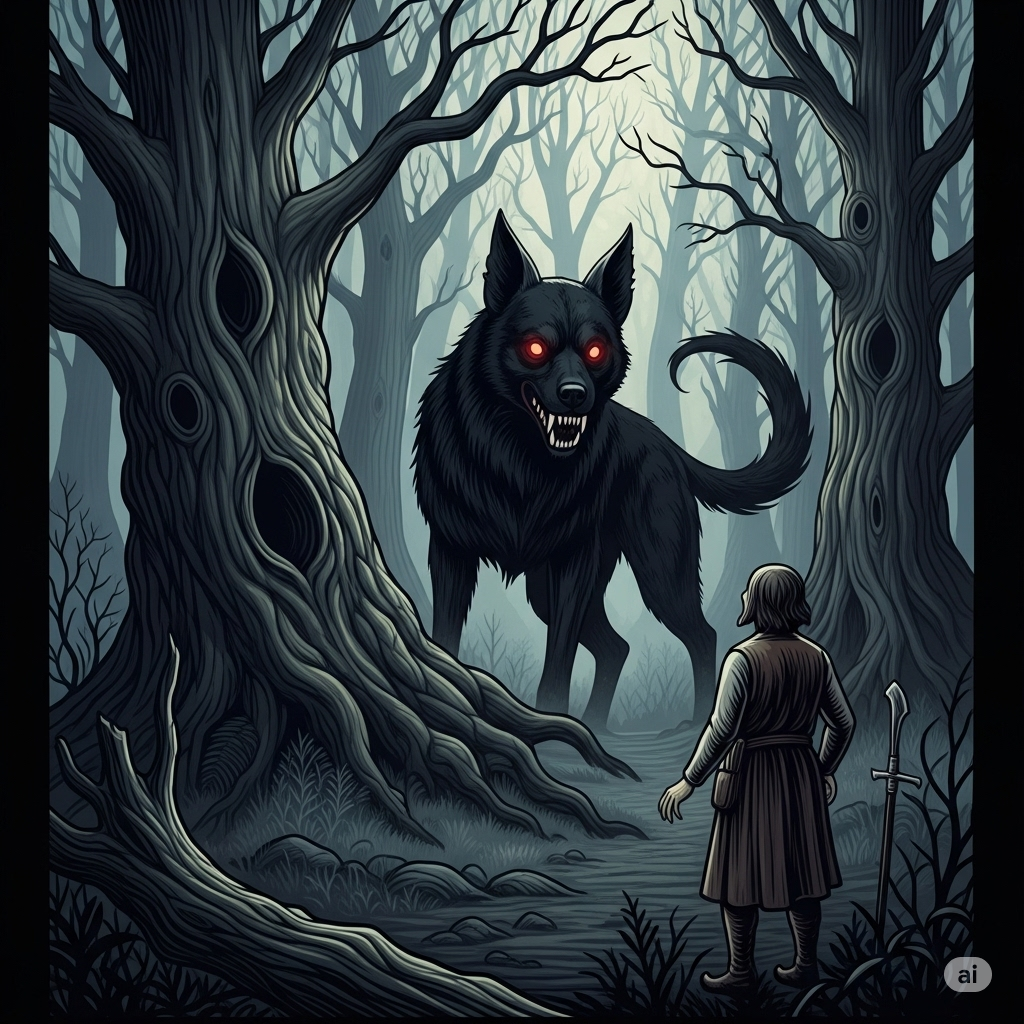Dark Omens and Haunted Roads
Across windswept moors, lonely crossroads, and fog-covered paths, a shadow lingers in European folklore: the black dog. More than just a stray animal, this spectral creature appears in legends as a supernatural harbinger, often tied to death, misfortune, and the unknown. Its eyes glow red, its fur is pitch black, and its presence is rarely a good sign.
From England’s misty countryside to the coasts of Ireland and the forests of Germany, the myth of the black dog endures as one of the most haunting and fascinating motifs in Western folklore.
Origins of the Black Dog Myth
The black dog legend is ancient, with roots stretching back to pre-Christian times. It likely arose from a combination of:
Pagan beliefs about nature spirits and underworld guardians.
The widespread fear of wolves, which once roamed Europe.
The Christian association of darkness with evil and sin.
The black dog became a folkloric shorthand for supernatural guardianship—or warning, depending on the context. Though its role varies across regions, its symbolism remains eerily consistent: an omen of something beyond human control.
The Black Dog as a Harbinger of Death
In most traditions, encountering a black dog—especially at night or at a crossroads—was a sign of impending death or doom. People believed the dog could:
Predict the death of someone nearby.
Warn of a violent or unnatural fate.
Serve as a psychopomp, guiding souls to the afterlife.
These stories transformed the black dog into a creature of both terror and reverence—feared, yet respected.
Regional Variations of the Black Dog
While the core idea is universal, the black dog takes on different forms and names across European cultures:
🇬🇧 England – The Barghest, Black Shuck, and Padfoot
Black Shuck: A legendary hound said to roam East Anglia. Described as the size of a calf with burning eyes, Black Shuck is infamous for haunting churchyards and coastlines.
Barghest: Found in Northern England, particularly Yorkshire. This monstrous dog is said to foretell death and may even appear at funerals.
Padfoot: A stealthier variant with chains or dragging sounds—its appearance is a death sentence for the observer or someone close to them.
These dogs were often invisible to others and vanished when approached, increasing their mythic aura.
🇮🇪 Ireland – The Cu Sith and Churchyard Guardians
In Irish folklore, black dogs often guard sacred or cursed places—particularly graveyards and burial mounds. The Cu Sith, while sometimes green, shares traits with the black dog: large, spectral, and tied to death.
Dogs were also thought to accompany the banshee or precede her wailing cries, forming a chorus of doom.
🇩🇪 Germany – Der Schwarze Hund
In German folklore, the Schwarze Hund (black dog) appears at night to warn travelers or punish those who disturb the dead. In some tales, it is a demonic entity, while in others, it is a cursed soul trapped in dog form.
Symbolism and Interpretations
The myth of the black dog speaks to deeper human fears—of isolation, mortality, guilt, and the unseen. Across cultures, it symbolizes:
The shadow self: The parts of ourselves we fear or repress.
Mental torment: The black dog has been used as a metaphor for depression, most famously by Winston Churchill.
Spiritual transition: As a guardian or gatekeeper, the dog may serve as a bridge between life and death.
Its haunting presence reminds us of the fragility of life and the mystery of what lies beyond.
In Popular Culture
The black dog has prowled into modern culture, where it continues to evolve:
Literature: Featured in The Hound of the Baskervilles by Arthur Conan Doyle, one of the most iconic representations.
Music: Led Zeppelin’s song “Black Dog” draws on the symbol’s emotional intensity.
Video Games and Movies: Spectral dogs appear as bosses, omens, and familiars—such as in Harry Potter (the Grim), Bloodborne, and The Witcher series.
Its enduring appeal lies in its primal symbolism and open-ended menace.
Conclusion: The Shadow That Lingers
The myth of the black dog endures because it speaks to the universal fear of what cannot be seen or explained. Whether as a guardian of the dead, a warning from the spirit world, or a symbol of personal struggle, the black dog remains one of Europe’s most powerful and unnerving folkloric figures.
So if you’re walking a lonely road at night and you hear the soft pad of paws behind you—don’t turn around.
You might not like what you see.







